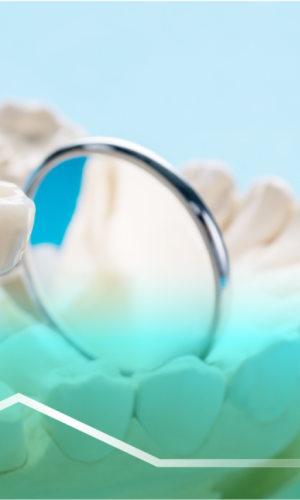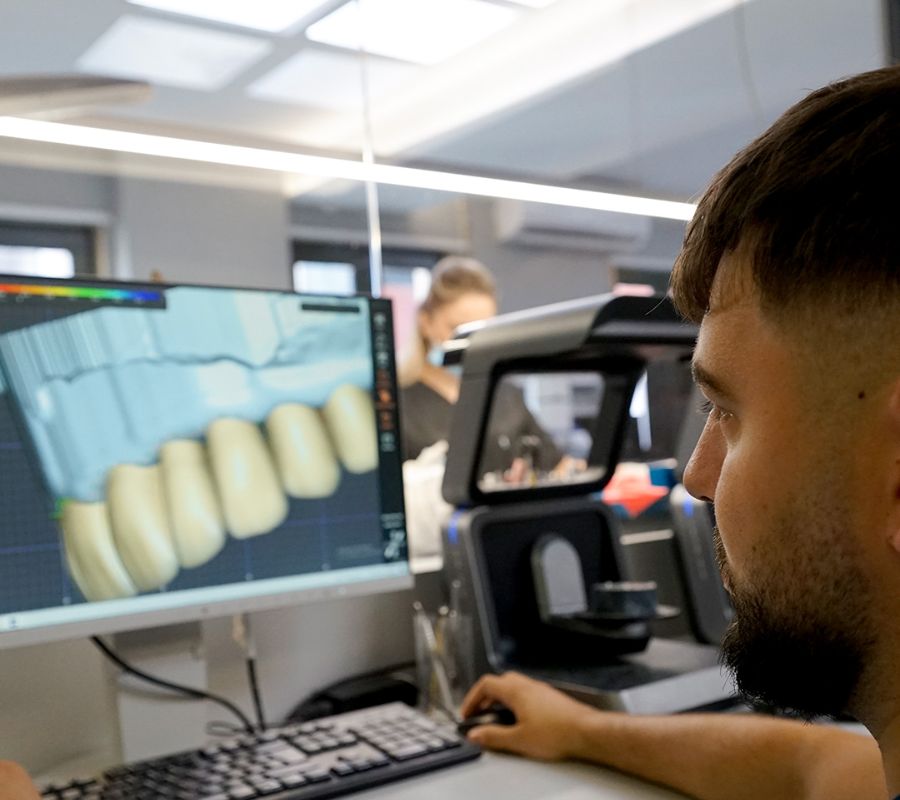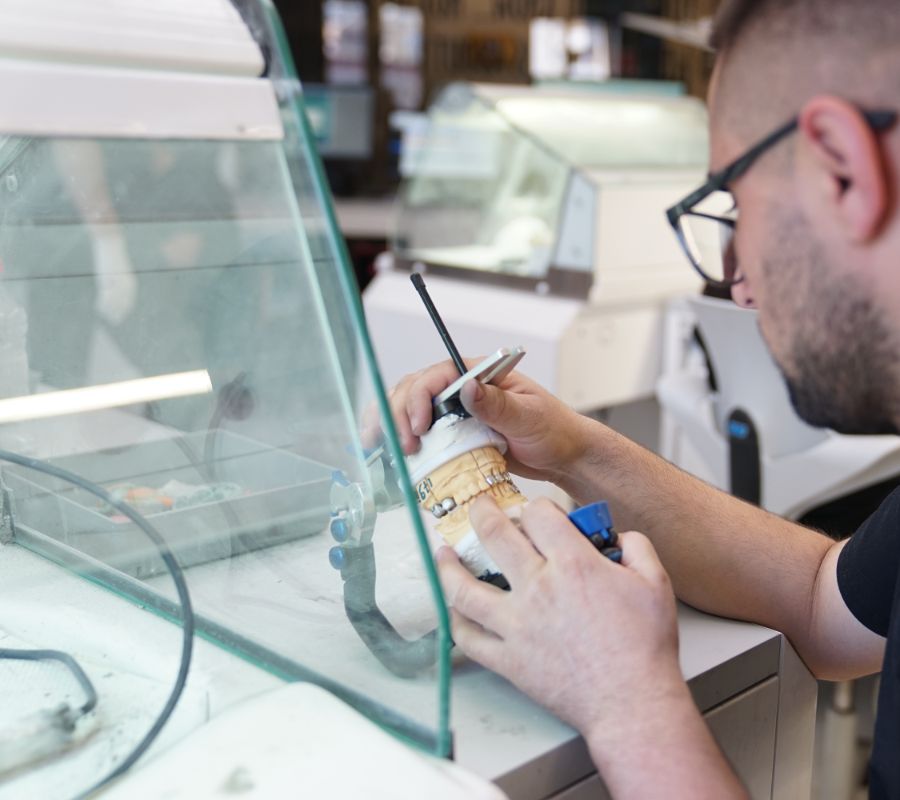Aesthetic Dentistry
The importance of aesthetics.
Nowadays aesthetics has a special importance, and since the face and especially the mouth and teeth play an important role, the need has arisen for the development of aesthetic dentistry.
People love beauty and want to look beautiful, and in cases when there are problems in someone’s smile, then through specific techniques, super aesthetic materials and surgical interventions a perfect smile is realized. Below we explain some of the materials and techniques used:



Gums treatment
Aesthetic Surgery of the Gums.
This intervention consists of removing part of the bone and gums that surround the teeth. After this intervention, the gums are expected to heal for 6 weeks and then prosthetic work can be continued. This intervention is done in the following cases:
1. Gummy Smile; are the cases when the gingiva (gums) of the person is very evident during a smile or a laugh. In these cases the level of the gingiva rises higher and then the teeth are coated with porcelain veneers (Laminate) or with porcelain crowns.
2. In cases when the gums are enlarged, as a result of the use of various medicines or gum diseases, and cover a part of the teeth.
3. In cases where we have a difference in the length of the first teeth. By interfering with the gingiva part we can make the teeth have the same length.
4. In cases when the length of the tooth is insufficient to perform work on it, intervention is made by making an extension of the crown (Crown Lengthening).
What is the most common surgery?
The most common surgery is the removal of mature teeth, the removal of worn teeth (retined) and also the removal of teeth to enable the straightening of the teeth with orthodontic appliances and the placement of dentures. One of the most important interventions is the removal of residual roots that can lead to bone infections and cysts.
Teeth whitening
Why do teeth change color??
The causes of tooth discoloration are many, such as: various medications, tooth trauma (fractures, impacts, etc.), tooth nerve removal.
The use of antibiotics such as tetracycline by the mother during pregnancy or by the baby, affects the discoloration of the baby’s teeth; in some cases, special foods or beverages such as Coca Cola, coffee, foods that have coloring in the composition, affect the color of the teeth.
How does bleaching happen (work)?
The substances used for bleaching are: Carbamide Peroxide and Hydrogen Peroxide (hydrogen peroxide). These two substances have the ability (quality) to pass freely through the layers of the tooth (enamel, dentin) and spread to all parts of the tooth. These Peroxides (Carbamide and Hydrogen peroxide) are broken down into oxygen radicals, which enter between the enamel prisms (outer layer of the tooth), dispersing (destroying) the colored molecules that affect the color of the tooth.
Whitening does not affect the structure of the tooth, only that the inner color of the tooth becomes whiter.
Bleaching agents break down into smaller molecules and move in all directions inside the tooth. Even if the whole tooth is not covered with bleach, it whitens the whole.
Numerous scientific studies have proven the effectiveness of peroxides in teeth whitening.
Enamel and dentin (two layers of tooth), existing fillings and porcelain are not affected, or damaged by bleaching agents.

Does whitening affect the connection between the filling and the tooth?
Although whitening agents release large amounts of oxygen into the teeth, the bonds of existing fillings to the teeth are not affected.
But if white fillings are to be made after bleaching, they should be waited for a period of 7-10 days, as the high amount of oxygen in the teeth negatively affects the filling of the tooth (for new fillings to be made).
How long does the bleaching effect last?
The bleaching results are consistent. However, depending on your eating habits and lifestyle, you may need to repeat the bleaching every 2 years.
To maintain the whitening effect unchanged, regular use of whitening paste recommended by the doctor is recommended.
Does bleaching cause hypersensitivity?
Hypersensitivity is a temporary side effect of bleaching. It will stop at the end of the bleaching session. Recent teeth bleaching products are now compounded of elements like potassium nitrate that eliminates hypersensitivity.
According to scientific research potassium nitrate penetrates the enamel, the dentine and even the pulp tissue acting like a sedative (analgesic and anesthetic effect).
Teeth bleaching materials contain fluorides which are used in teeth hypersensitivity treatment and caries prevention.
Does the tooth whitening cause problems weakening the tooth enamel (the outer layer)?
Teeth whitening should be performed only under dentist monitoring.
It’s not an allowed procedure during pregnancy and breast feeding period.
Teeth whitening nowadays are effective and safe, if done in the appropriate manner and with the suitable material. This includes a careful primary diagnose, teeth professional cleaning of stones and present stains, teeth whitening procedure explanation and monitoring during bleaching process.
Domestic teeth bleaching with cosmetic materials might cause gingival irritation and have a low efficiency.
How many ways are there for bleaching?
1. Office bleaching ; performed in a dental clinic, lasts around 30 minutes, different sessions can be done according to patients wish for a specific tooth shade. There is a high percentage of whitening active ingredient (35-38% Hydrogen Peroxide).
2. Home Bleaching: Merret masa e gojës dhe përgatiten këllëf silikoni, që mbushen me lëndë zbardhuese dhe mbahen në gojë gjatë ditës ose natës. Koha e mbajtjes varion nga 45 min deri në gjithë natën në varësi të përqindjes së lëndës aktive që bën zbardhimin (10%-15%-20%-22% Karbamide Peroksid).
3. Non-vital bleaching: Bleaching done to teeth after nerve removal that have changed their color. In these cases the tooth filling is removed and the bleaching material is placed in the cavity and left there for 3-5 days. It will be repeated until the desired bleaching effect is reached; a temporary filling is put in place for 10-15 days waiting for the oxygen level to decrease than the final filling can be done.
FAQ
Frequently asked questions.

Advantages
Porcelain veneer Emax Ivoclar.
Porcelain veneers are the most modern methods that realize a perfect aesthetics and at the same time preserve the structure of the tooth.
Porcelain veneers are very durable. Although they have a very small thickness of 0.5-0.7mm, when glued to the natural tooth structure they become very strong, and with proper care can last up to 10 or 15 years.
They are very aesthetic. Porcelain veneers provide a very natural look to the tooth because the refraction of light in the porcelain gives the same effect as tooth enamel.
They do not change color over time. Unlike composite, porcelain has a smooth surface that does not allow food or liquids to accumulate and change color.
They are conservative. Tooth preparation for porcelain veneers is minimal, thus preserving the normal structure of the tooth.
What problems can be solved with veneers?
Dental veneers are also called “rapid orthodontics” because they can cover a range of dental problems in the frontal area:
– The space between the front teeth
– Teeth with not a very aesthetic shape
– Broken front teeth on the cutting edge
– Teeth that have changed color on the surface or inside (devital teeth)
– Teeth with non-aesthetic filling

